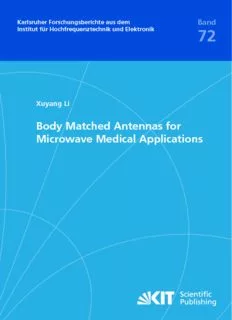
Body Matched Antennas for Microwave Medical Applications PDF
Preview Body Matched Antennas for Microwave Medical Applications
Karlsruher Forschungsberichte aus dem Band Institut für Hochfrequenztechnik und Elektronik 72 Xuyang Li s n o ati Body Matched Antennas for c pli p Microwave Medical Applications A al c di e M e v a w o r c Mi r o f s a n n e t n A d e h c t a M y d o B Li X. Xuyang Li Body Matched Antennas for Microwave Medical Applications Karlsruher Forschungsberichte aus dem Institut für Hochfrequenztechnik und Elektronik Herausgeber: Prof. Dr.-Ing. Thomas Zwick Band 72 Body Matched Antennas for Microwave Medical Applications by Xuyang Li Dissertation, Karlsruher Institut für Technologie (KIT) Fakultät für Elektrotechnik und Informationstechnik, 2013 Impressum Karlsruher Institut für Technologie (KIT) KIT Scientific Publishing Straße am Forum 2 D-76131 Karlsruhe KIT Scientific Publishing is a registered trademark of Karlsruhe Institute of Technology. Reprint using the book cover is not allowed. www.ksp.kit.edu This document – excluding the cover – is licensed under the Creative Commons Attribution-Share Alike 3.0 DE License (CC BY-SA 3.0 DE): http://creativecommons.org/licenses/by-sa/3.0/de/ The cover page is licensed under the Creative Commons Attribution-No Derivatives 3.0 DE License (CC BY-ND 3.0 DE): http://creativecommons.org/licenses/by-nd/3.0/de/ Print on Demand 2014 ISSN 1868-4696 ISBN 978-3-7315-0147-3 Editor‘s Preface Originally motivated by the ever increasing demand on the high data rate in the field of mobile communication, intensive research has been underway since many years on a new technology: the ultra wideband (UWB) technology. The transmit signal spreads in a huge bandwidth, which results in an extremely low power spectrum density and there- fore low interference to other radio communication services. The frequency spectrum released in many parts of the world since some years ago paves the way for the future commercial UWB systems and their research works. Meanwhile, the research focus on applications relevant to UWB has shifted definitively to radar. Of these research works, the medical diagnosis based on UWB technology plays an es- sential role. Though in general the UWB technology cannot achieve the performance of the existing technologies such as magnetic reso- nance imaging (MRI), computed tomography (CT scan) and sonog- raphy using ultrasound, the imaging systems based on microwaves could well be a complementary method to these existing medical di- agnosis systems. On the one hand, the new UWB systems can be considerably much cheaper and more portable than MRT and CT. On the other hand, microwaves have an advantage compared to ultra- sound, in that they can penetrate through the bone and “see” the tissues behind it. Besides that, the UWB technology enables wireless data transmission from implantable sensors inside the human body to outside equipment with relatively high data rates. However, all of the medical applications based on UWB technology have a common problem: the relatively high signal attenuation caused by the hu- man tissues. A basic approach to solving this problem is to place the antenna directly on the body. In this way, the strong reflection from the boundary of air and human body can be significantly reduced. Moreover, the approach allows a reduction of the antenna size due to the reduced wavelength, which is not only essential for implanted devices but also for a medical imaging system, since multichannel systems with an antenna array are required. In his dissertation Mr. Li developed the concepts and basic techniques for the realization of body-matched antennas for medical applications. The major challenges of this work were caused by the fact that these antennas will directly radiate into a medium different from vacuum/air. This does not only lead to different antenna concepts and designs but also does not allow an antenna characterization by the standard an- tenna measurement setups. Therefore Xuyang Li also had to develop a novel antenna characterization setup for body-matched antennas, and I am positive that his work will attract much interest from the research community worldwide. With his new miniaturization and optimization strategies for ultra-wideband body-matched antennas Mr. Li achieved significant size reductions with concurrent efficiency maximization so I strongly believe that his work will draw attention in the research community worldwide. My personal wish for Mr. Li is that his creativ- ity and great engineering talent together with his organizational skills and team spirit will continue to earn him both scientific and economic success. Prof. Dr.-Ing. Thomas Zwick – Director of the IHE –
Description: